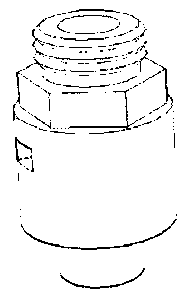Une partie des informations de ce site Web a été fournie par des sources externes. Le gouvernement du Canada n'assume aucune responsabilité concernant la précision, l'actualité ou la fiabilité des informations fournies par les sources externes. Les utilisateurs qui désirent employer cette information devraient consulter directement la source des informations. Le contenu fourni par les sources externes n'est pas assujetti aux exigences sur les langues officielles, la protection des renseignements personnels et l'accessibilité.
L'apparition de différences dans le texte et l'image des Revendications et de l'Abrégé dépend du moment auquel le document est publié. Les textes des Revendications et de l'Abrégé sont affichés :
| (12) Demande de brevet: | (11) CA 2596313 |
|---|---|
| (54) Titre français: | SOUPAPE DE SECURITE |
| (54) Titre anglais: | PRESSURE VALVE |
| Statut: | Réputée abandonnée et au-delà du délai pour le rétablissement - en attente de la réponse à l’avis de communication rejetée |
| (51) Classification internationale des brevets (CIB): |
|
|---|---|
| (72) Inventeurs : |
|
| (73) Titulaires : |
|
| (71) Demandeurs : |
|
| (74) Agent: | |
| (74) Co-agent: | |
| (45) Délivré: | |
| (22) Date de dépôt: | 2007-07-31 |
| (41) Mise à la disponibilité du public: | 2009-01-31 |
| Requête d'examen: | 2007-07-31 |
| Licence disponible: | S.O. |
| Cédé au domaine public: | S.O. |
| (25) Langue des documents déposés: | Anglais |
| Traité de coopération en matière de brevets (PCT): | Non |
|---|
| (30) Données de priorité de la demande: | S.O. |
|---|
The Pressure Valve can control the passage that the source pass through. The
effective area of the measuring element is smaller before the valve opens,
and the effective area of the measuring element is larger when the valve
opens. Higher source pressure is needed to open the valve and lower source
pressure is needed to keep it open. The magnetic force between the magnet
and the diaphragm attracts the diaphragm toward the magnet, the force is
much stronger when the diaphragm contacts the magnet. With the help of
magnetic force, the source pressure needs to go down more to make the
spring force to overcome the magnetic force and source pressure, the valve
close at lower source pressure. It provides a method to prevent fluid from
flowing from target end to the source end when the source pressure goes
down to certain level. The Pressure Valve is designed for expansion tank of
a boiler system. With the Pressure Valve, an expansion tank can be
pre--presurized with vapor, and will have more capacity.
Note : Les revendications sont présentées dans la langue officielle dans laquelle elles ont été soumises.
Note : Les descriptions sont présentées dans la langue officielle dans laquelle elles ont été soumises.

2024-08-01 : Dans le cadre de la transition vers les Brevets de nouvelle génération (BNG), la base de données sur les brevets canadiens (BDBC) contient désormais un Historique d'événement plus détaillé, qui reproduit le Journal des événements de notre nouvelle solution interne.
Veuillez noter que les événements débutant par « Inactive : » se réfèrent à des événements qui ne sont plus utilisés dans notre nouvelle solution interne.
Pour une meilleure compréhension de l'état de la demande ou brevet qui figure sur cette page, la rubrique Mise en garde , et les descriptions de Brevet , Historique d'événement , Taxes périodiques et Historique des paiements devraient être consultées.
| Description | Date |
|---|---|
| Inactive : Morte - Aucune rép. à lettre officielle | 2010-01-18 |
| Demande non rétablie avant l'échéance | 2010-01-18 |
| Réputée abandonnée - omission de répondre à un avis sur les taxes pour le maintien en état | 2009-07-31 |
| Demande publiée (accessible au public) | 2009-01-31 |
| Inactive : Page couverture publiée | 2009-01-30 |
| Inactive : Abandon. - Aucune rép. à lettre officielle | 2009-01-19 |
| Inactive : Correction à la modification | 2008-10-17 |
| Modification reçue - modification volontaire | 2008-08-12 |
| Inactive : Lettre officielle | 2008-07-23 |
| Modification reçue - modification volontaire | 2008-05-22 |
| Inactive : Dem. de l'examinateur par.30(2) Règles | 2008-04-08 |
| Inactive : CIB en 1re position | 2008-01-18 |
| Inactive : CIB attribuée | 2008-01-18 |
| Inactive : CIB attribuée | 2008-01-18 |
| Inactive : CIB attribuée | 2007-12-21 |
| Inactive : CIB en 1re position | 2007-12-21 |
| Modification reçue - modification volontaire | 2007-11-14 |
| Inactive : Lettre officielle | 2007-09-07 |
| Demande reçue - nationale ordinaire | 2007-09-05 |
| Lettre envoyée | 2007-09-05 |
| Inactive : Certificat de dépôt - RE (Anglais) | 2007-09-05 |
| Toutes les exigences pour l'examen - jugée conforme | 2007-07-31 |
| Exigences pour une requête d'examen - jugée conforme | 2007-07-31 |
| Déclaration du statut de petite entité jugée conforme | 2007-07-31 |
| Date d'abandonnement | Raison | Date de rétablissement |
|---|---|---|
| 2009-07-31 |
| Type de taxes | Anniversaire | Échéance | Date payée |
|---|---|---|---|
| Taxe pour le dépôt - petite | 2007-07-31 | ||
| Requête d'examen - petite | 2007-07-31 |
Les titulaires actuels et antérieures au dossier sont affichés en ordre alphabétique.
| Titulaires actuels au dossier |
|---|
| JIANMING YANG |
| Titulaires antérieures au dossier |
|---|
| S.O. |